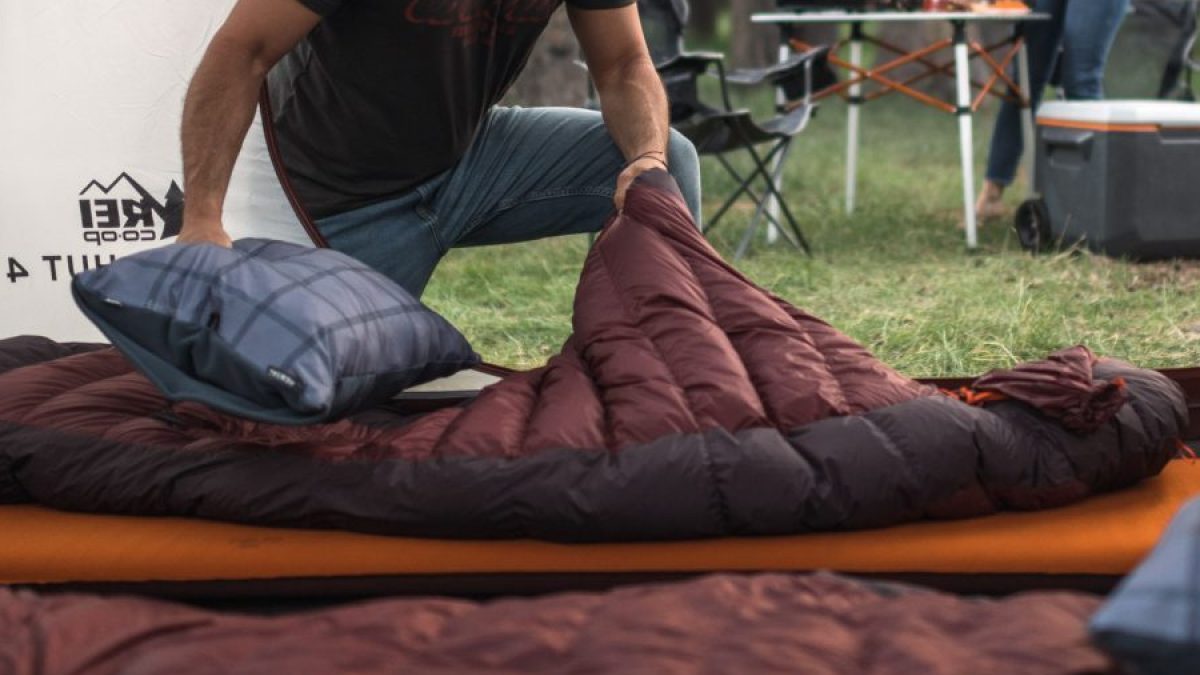Editor’s note: This article was published in 2020. As a result, some of the products might be out of stock when you read this gear guide. We are in the process of updating it with new recommendations.
We’ve come a long way from the days when campers laid out bedrolls on pine boughs. Sleeping pads have been getting cushier and lighter for decades. Pad progress recently, though, has taken more of a quantum leap, thanks, in part, to new standardized R-value testing in the industry, which provided brands with new data about the warmth of pads.
The net result of such testing for you, dear sleeper, is a lot of brand-new, appropriately warm pads to choose from, as well as many classics with refinements that make them even more slumberworthy. Our lineup of staff picks for both backpacking and car-camping sleeping pads this year includes debut designs, seasoned stalwarts and familiar favorites that received a full makeover.
Sleeping Pads for Backpacking
REI Co-op Trailbreak
Best Budget-Friendly Backpacking Pad

- Versions: Women’s regular and long; Unisex regular and long
- Pad type: Self-inflating foam
- R-value: 5.3 (W); 5.1 (U)
- Dimensions (for Regular): 66 x 20 x 1.75 in. (W); 72 x 20 x 1.75 in. (U)
- Weight (for Regular): 2 lbs. 5 oz. (W); 2 lbs. 8 oz. (U)
- Insulation: Open-cell foam
- Price: Starting at $69.95
If you’re just getting into the wonders of sleeping on the ground, you may be pleased with the addition of the REI Co-op Trailbreak to your sleep system. It pairs well its namesake, the women’s or men’s Trailbreak 30 sleeping bag, creating a complete system of just-right warmth, comfort and durability for around $160.
Self-inflating foam pads are hardly the new tech on the block, but they stick around for their predictable comfort and low weight. Many people also prefer the dependability of an open-cell foam pad over either an air pad or a closed-cell foam pad because it will still provide some warmth and cushioning if the pad springs a leak. The Trailbreak also includes some welcome refinements to the genre, including a plush stretch fabric on top that minimizes bag creep and color-coded valves that simplify and speed up inflation and deflation.
It’s also noteworthy that this pad has an R-value greater than 5 (5.5+ is suggested for extreme cold.) That kind of insulation performance goes a long way toward ensuring you a toasty night’s sleep. Buy here.
NEMO Tensor Insulated
Best Lightweight Backpacking Pad
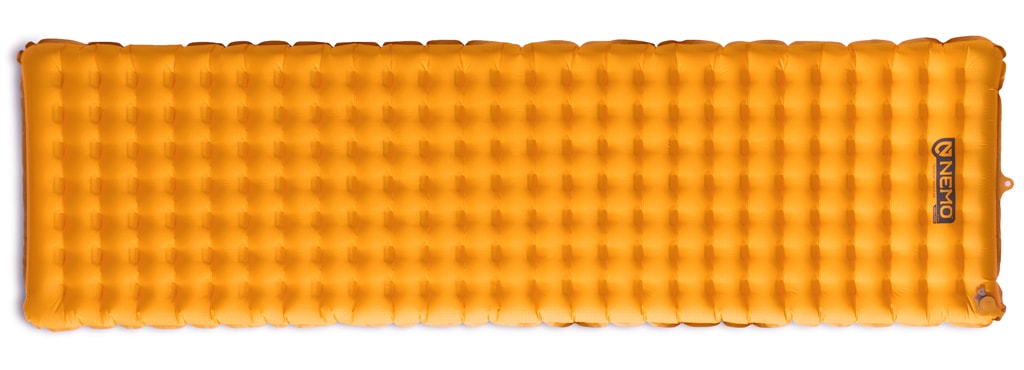
- Versions: Unisex regular, regular/wide and long/wide
- Pad type: Air pad
- R-value: 3.5
- Dimensions (for Regular): 72 x 20 x 3 in.
- Weight (for Regular): 15 oz.
- Insulation: Synthetic
- Price: Starting at $159.95
Sleeping pad experts in REI Co-op stores describe the NEMO Tensor Insulated as “that pad that does a lot of things really, really well.” It’s warm enough for three-season use, packs down to the size of a Nalgene bottle and is competitively priced. And you get all that at less than a pound.
What sets the Tensor Insulated apart from other lightweight air pads is NEMO’s Spaceframe™ baffles—vertical spacers that run the length of the pad to distribute your body weight evenly across the mattress. Two layers of space blanket-like reflective material (called Thermal Mirror™ technology) run across the Spaceframe™ for warmth without adding a ton of weight. That baffle design, coupled with a quilted top, makes Tensor Insulated a comfortable pad that’s far more stable than pads that have tubular air chambers. Bonus: REI pad experts lauded the Thermal Mirror™ technology, which makes this pad relatively quiet for a pad with reflective material inside.
Last, but not least, our staffers noted that the included pump sack, which rolls up to the size of a marker, makes quick work of inflation. Other pad brands have a variation of this, and the idea is the same: A billowy fabric sack lets you blow gently into the top to inflate that sack; then you seal it up and squeeze the sack, inflating the pad in the process. About three rounds of this routine will fully inflate the pad. You’re still blowing up your air pad, but in an efficient, non-hyperventilating sort of way. Buy here.
Therm-a-Rest Z-Lite Sol
Most Versatile Backpacking Pad
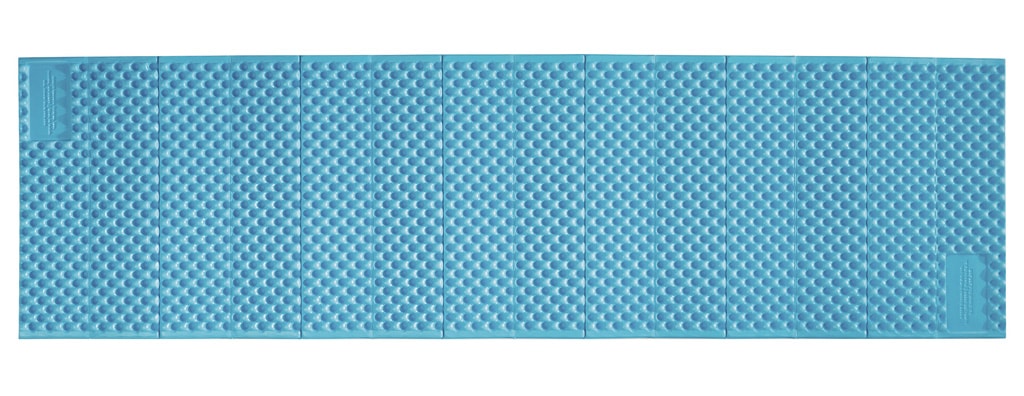
- Versions: Unisex regular
- Pad type: Closed-cell foam
- R-value: 2.0
- Dimensions: 72 x 20 x 0.75 in.
- Weight: 14 oz.
- Insulation: Closed-cell foam
- Price: $44.95
Closed-cell foam pads are not for everyone, but they have three virtues that their fans can’t resist: They’re economical, incredibly lightweight and virtually indestructible. The Z-Lite Sol checks all those boxes and adds a few refinements to this classic pad style. Therm-a-Rest varied the foam thickness, putting a softer layer on top. The brand also added a reflective coating to help prevent radiant heat loss. That’s not to suggest the pad is exceptionally warm: It has a modest 2.0 R-value (pretty similar to other closed-cell foam pads), which is barely enough for three-season camping.
But the beauty of a closed-cell foam pad is that its uses far outnumber its stated purpose. Put it on top of your air mat to create a warmer sleep system in colder weather (R-values are additive), or cut off the last section of the Z-Lite Sol and turn it into a go-anywhere sit pad. One staffer even used a sliver off the bottom to create an insulated cozy for her backpacking food pouches (BYO duct tape). Smash the pad into your camp chair to insulate your rear on frosty mornings, or arrange it on end to create a windbreak for your camp kitchen. “It was the ideal auxiliary pad for my trip,” declares one REI camping specialist, who carried the Z-Lite Sol on his Appalachian Trail thru-hike.
Perhaps one co-op customer review sums the Z-Lite Sol up best: “Compact, stores nicely, and does exactly what you need it to do.” Buy here.
Big Agnes Q-Core Deluxe
Most Luxurious Backpacking Pad

- Versions: Unisex regular, regular/wide, long/wide and XL wide
- Pad type: Air pad
- R-value: 4.3
- Dimensions (for Regular): 72 x 20 x 3.5 in.
- Weight (for Regular): 1 lb. 9 oz.
- Insulation: Synthetic
- Price: Starting at $159.95
To call any backpacking gear “luxurious” may seem a little disingenuous when, after all, you are still sleeping on the ground. Air pad technology is getting sophisticated enough, though, that a mattress like the Q-Core Deluxe can offer a pretty pampered experience. That it can do so and weigh just over a pound and a half is further testament to the current level of sleeping pad innovation.
The Q-Core Deluxe gets weary bodies a whopping 3.5 inches off the ground for sofa-cushion-like comfort. Inside that cavernous space, Big Agnes uses I-beam construction to promote stability; the offset I-beams dimple the pad, eliminating the need for linear air chambers. “The feel is more like a mattress spring,” one veteran camping specialist at the co-op says. “The result is that the pad transfers less motion and helps keep you in the middle.” Slightly thicker outer chambers (4.25 in.) cradle you in the center of the pad, too. A quilted top surface and a stretchy nylon-spandex fabric cover add to the luxury.
The Q-Core Deluxe uses PrimaLoft® Silver insulation, which adds a lot of warmth for very little weight. It also makes the pad quieter than pads that rely solely on heat-reflective panels inside. Still, the whole pad packs down to a bundle about the size of a small growler (for size regular). It comes with a pump sack to make inflation less of a chore, and its two one-way valves, one for inflation and one for deflation, simplify each task, and allow for fine-tuning firmness. Buy here.
Mountain Equipment Aerostat Down 7.0
Best Cold-Weather Backpacking Pad
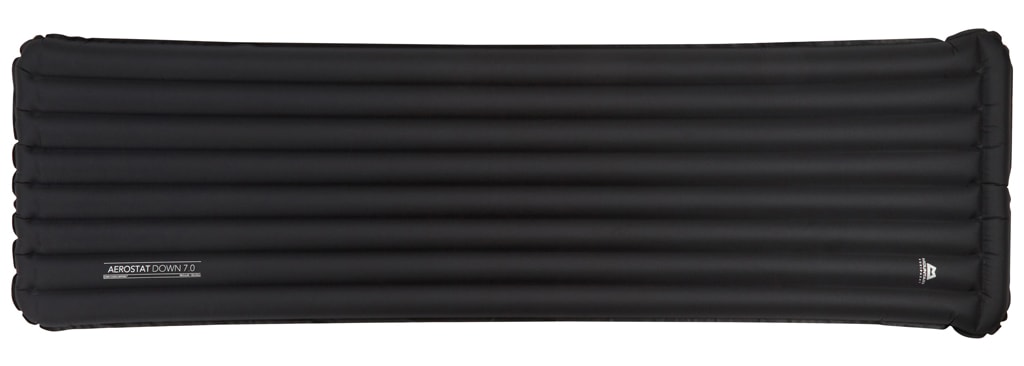
- Versions: Unisex regular and long
- Pad type: Air pad
- R-value: 5.0
- Dimensions (for Regular): 8 x 21.25 x 2.8 in.
- Weight (for Regular): 1 lb. 4.4 oz.
- Insulation: 700-fill-power down
- Price: Starting at $205
The Mountain Equipment Aerostat Down 7.0 is thick, warm and lightweight, though not the thickest, warmest or lightest cold-weather sleeping pad you will find. It’s one of those pads that hits exactly the right notes for folks who might take the thing out in colder temps, but not exclusively. One co-op customer review sums it up this way: “I have a few really nice ultralight pads, but they sleep cold if it’s below 45°F. This takes care of all that for just a few ounces more.”
Inside the pad, Mountain Equipment uses a classic sleeping-bag insulation that’s also made its way inside a handful of air pads: Xtherm’s 700-fill-power down. The natural insulation offers ample warmth for the weight with an R-value of 5.0 in a package that weighs a pound and change. For structure, there’s a system of vertical baffles and strategically placed foam plugs that stabilize the pad under bodyweight and keep the down from migrating.
Other components of the pad include the Windsock™, a pump sack that eases inflation, along with a clever self-sealing, two-way valve that is used for both inflation and deflation. Both features make for rapid pad deployment in the field. Buy here.
Therm-a-Rest NeoAir XTherm
Best Winter Backpacking Pad
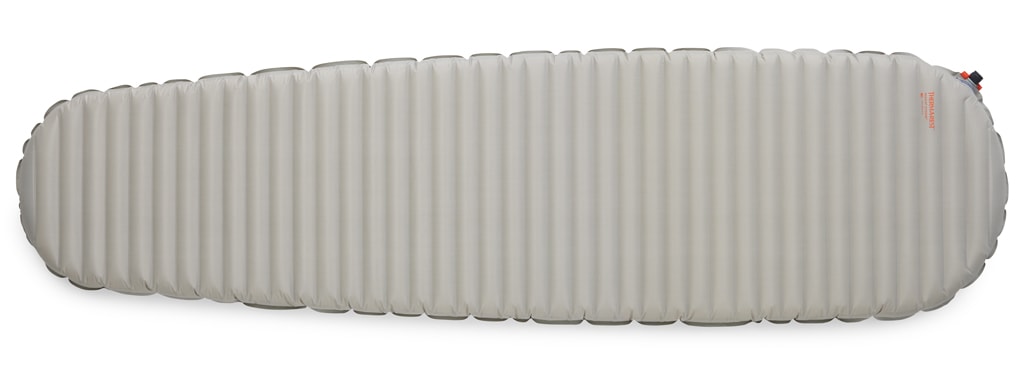
- Versions: Unisex regular and large
- Pad type: Air pad
- R-value: 6.9
- Dimensions (for Regular): 72 x 20 x 2.5 in.
- Weight (for Regular): 15 oz.
- Insulation: Synthetic
- Price: Starting at $214.95
In the words of one REI pad expert, “Having a pad with an R-value of almost 7 for less than a pound is absurd.” Or brilliant, if you’re smart enough to get one before your next winter backpacking expedition or Denali ascent. Or maybe you just sleep extra cold and happen to like ultralight pads.
That astounding level of warmth comes from a pair of Therm-a-Rest technologies: ThermaCapture™ is the heat-reflective coating that radiates warmth back to your body and prevents heat loss, and Core Matrix™ refers to the layers of triangular baffles that create a stable sleep surface, also without allowing your body heat to escape. Between the two technologies, the NeoAir XTherm boasts one of the best warmth-to-weight ratios on the market. It might not be the quietest pad at night, but that’s a minor concern if you’re a heat-seeker, an ounce counter—or both.
The NeoAir XTherm, like many pads in our roundup, comes with a pump sack and an elegant valve design. The latter lets you accomplish both inflation and deflation through a single valve that vaguely resembles a wingnut. Rotate the wings one way and you have a one-way inflation valve; rotate the wings the other way and it transforms into a one-way deflation valve. Buy here.
Sleeping Pads for Car Camping
REI Co-op Camp Bed
Best All-Around Car-Camping Pad
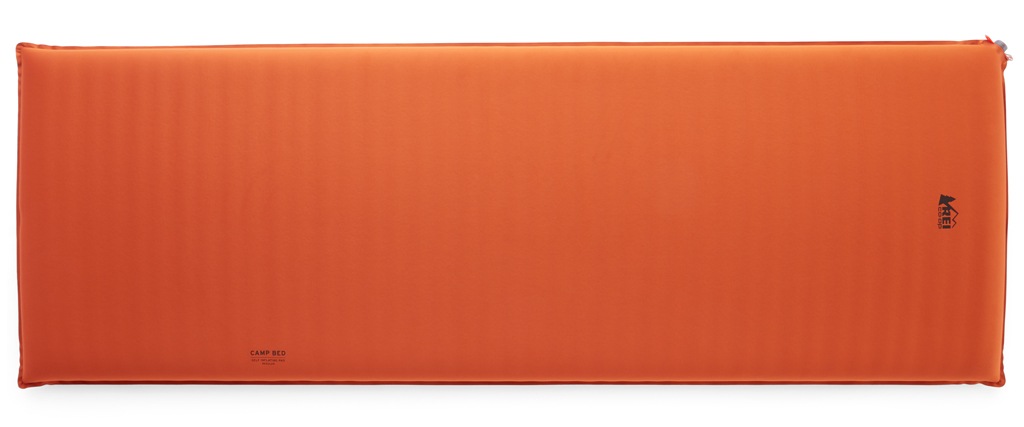
- Versions: Unisex regular and XL
- Pad type: Self-inflating foam
- R-value: 7.6
- Dimensions (for Regular): 72 x 25 x 2.5 in.
- Weight (for Regular): 3 lbs. 10 oz.
- Insulation: Open-cell foam
- Price: Starting at $99.95
This venerable workhorse in the REI Co-op sleeping-pad lineup has long been a hit with customers, one of whom summed it up by saying: “Great car-camping pad. Tons of padding and easy to set up and pack up.” We couldn’t agree more.
Belying its relatively affordable price, the Camp Bed boasts 2.5 inches of cush, plus a T-shirt-soft cover on top for supreme comfort. “A lot of car-camping pads can feel a bit like sleeping on a balloon,” explains a sleeping-pad expert who works in our Farmington, Utah, REI Co-op store. “The Camp Bed, though, feels more like your home mattress.” It’s quiet like it, too.
In addition to comfort, the Camp Bed’s 7.6 R-value puts its warmth on par with winter sleeping pads. That rating makes this pad versatile enough for a January overnight, as well as a quilt-only summer sojourn.
Setting up the Camp Bed is a snap: Unroll it, open the high-flow valve and let outside air pressure do most of the work for you. Add a few more breaths and you’re done. When it’s time to break camp, simply open up the high-flow valve, then force out the remaining air by rolling the pad up for packing. Buy here.
Exped MegaMat Max 15 Duo Sleeping Pad
Best Double Pad for Car Camping
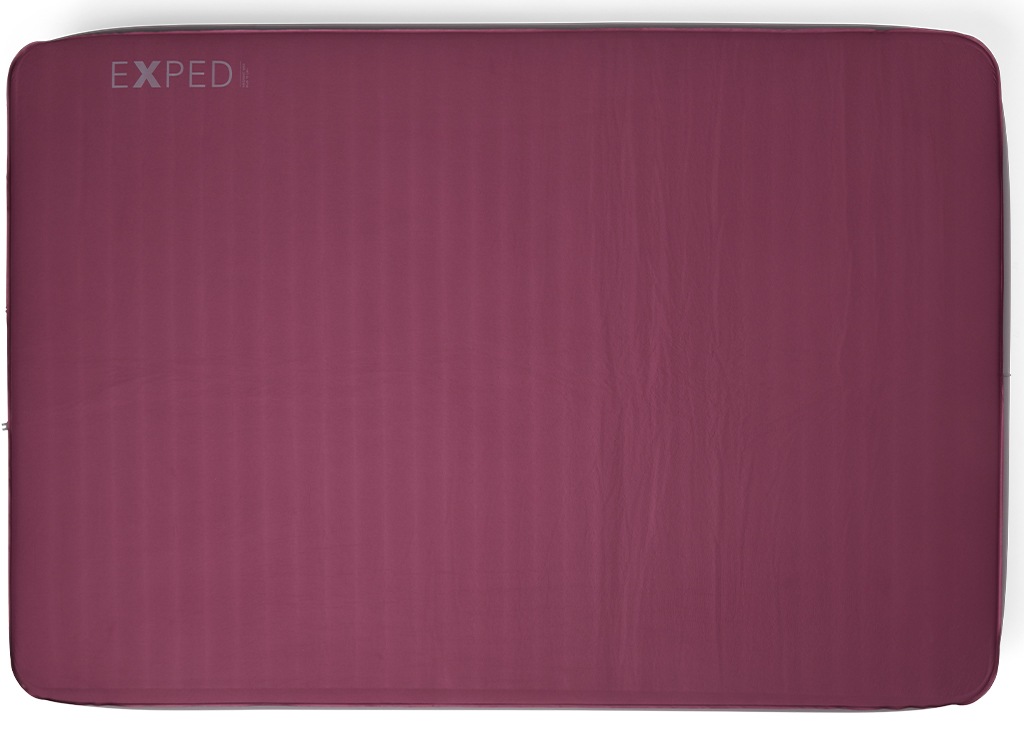
- Versions: Unisex double/long
- Pad type: Self-inflating foam
- R-value: 10.6 (not a typo)
- Dimensions: 77.6 x 52 x 6 in.
- Weight: 13 lbs.
- Insulation: Open-cell foam
- Price: $429
Put simply: The MegaMat Max 15 is for camping duos with an insatiable appetite for comfort. And if you make the investment, stratospheric comfort is exactly what Exped delivers. One customer reviewer put it this way: “I honestly get better rest than I do in my king-size bed.”
Your soft tactile experience starts at the top of the pad, which is covered with a stretch nylon-tricot fabric that feels a lot like jersey sheets, if you’re into those. The heart of the pad is 6 inches of cored open-cell foam, making the MegaMat Max a softie through and through. And all that foam gives the mattress an R-value that’s more than double that of others on this list. In other words, if you want to sleep on snow, go for it. (For its part, though, the MegaMat Max is not compact. It packs down to a bundle the size of a toddler.)
The MegaMat Max does a solid job of self-inflating for such a large pad. After that, the included pump makes quick work of firming it up, and sleepers can make minor adjustments from bed thanks to a handy push-pen in the valve.
Perhaps this co-op customer reviewer sums it up best: “Spent the small fortune required to purchase this mat and have no regrets.” Buy here.
HEST Sleep System Sleeping Pad
Best Glamping Pad
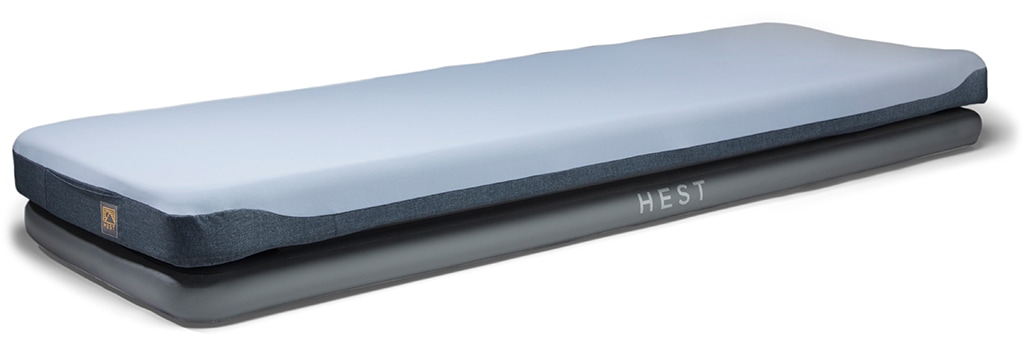
- Versions: Unisex long/wide
- Pad type: Hybrid
- R-value: 11.8 (also not a typo)
- Dimensions (for Regular): 78 x 25 x 7 in.
- Weight (for Regular): 26 lbs.
- Insulation: Open-cell foam
- Price: $399
If the idea of mixing technologies from inflatable stand up paddle boards (SUPs) and home mattresses sounds a little out there, then you’re not alone in thinking that. But as it turns out, the combination yields some especially cushy results, and fortunately HEST saw the potential in this unexpected pairing when creating its Sleep System Pad.
The 7-inch-thick home-mattress portion of the sleep system has a layer of memory foam on top of a firmer, more stable polyurethane foam substrate. Cover all that with a stretchy wicking nylon fabric and you’ve created something that may be a step up from what you’re sleeping on at home. (Nice touch: The cover zips off for washing.)
The air-filled base is as close to an indestructible air pad as you can find at REI, thanks to the beefy casing and drop-stitch construction borrowed from inflatable SUPs. The other advantage to this technique, where thousands of tightly packed high-tensile threads connect the top and bottom of the air-filled base, is the rigidity it provides. Short of bringing your platform bed to the campground, you’d be hard-pressed to find a more luxurious setup.
At nearly $400 and more than 25 pounds, this isn’t the sleep system for everyone. But if a decadently comfortable night’s rest is what you’re after, this is it. Buy here.
REI Co-op Kindercamp
Best Kids’ Sleeping Pad
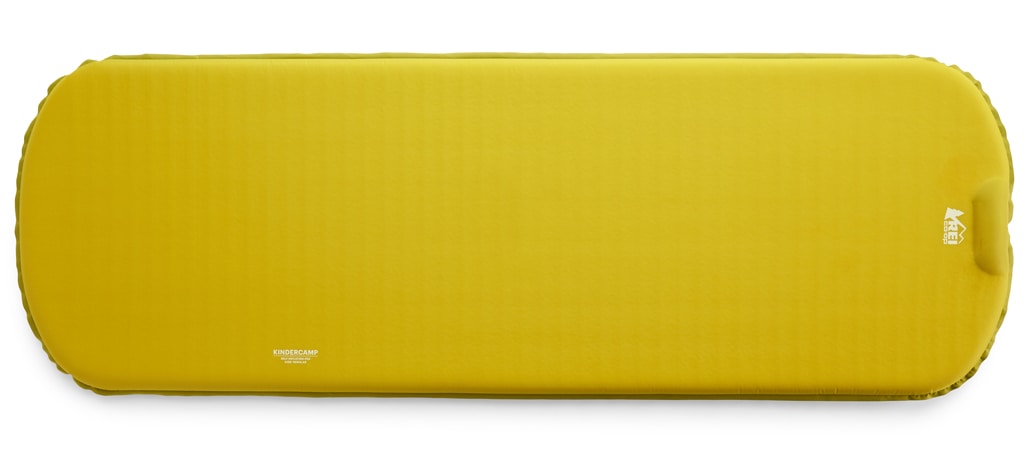
- Versions: Kids’
- Pad type: Self-inflating foam
- R-value: 4.5
- Dimensions: 60 x 20 x 1.5 in.
- Weight: 1 lb. 13 oz.
- Insulation: Open-cell foam
- Price: $49.95
The Kindercamp, which has been the default starter pad of parents who shop at REI Co-op for years, has long had one minor gripe: that it isn’t quite warm enough. That changes with this year’s Kindercamp, which is nearly twice as warm as past iterations (an R-value of 4.5 this year compared to 2.5 in past years).
REI Co-op designers also made the pad thicker (1.5 inches this year compared to just 1 inch previously), which both boosted the R-value and the cushiness factor. The pad is made using the same horizontally cored open-cell foam as REI’s adult pads, too, so it packs down small enough to fit in the included 5-by-12-inch stuff sack.
Parents also reported that they preferred a slightly wider pad, so the other noteworthy upgrade in this year’s Kindercamp is its dimensions: The pad is now 20 inches wide, compared to 18 inches before.
It’s worth noting that, despite rounding the corners to shave a few ounces, the net result of these upgrades is a slight weight penalty. This year’s Kindercamp is 10 ounces heavier than its predecessor, which was intended more for backpacking. Kids can certainly use the pad for both activities, though, which might also make this year’s Kindercamp more versatile than last year’s. Buy here.
Buying Advice
When shopping for a backpacking sleeping pad, you’re juggling the big three: low weight, adequate warmth and, well, padding. Specs tell the tale for weight and warmth; cushiness is more subjective. Size affects weight, of course, and, if you’re looking at an extra-wide and/or long pad, you should double check the dimensions of your tent to make sure it fits inside OK.
Size also affects comfort if you’re tall or like to spread out while you sleep. A standard regular-size pad is typically 72 inches by 20 inches. A number of pads come in 76-inch or 78-inch versions, and a few also come in 25-inch-wide versions.
If you’re looking for a car-camping sleeping pad, your motorized packhorse is doing the heavy lifting, so just pick the warmest, cushiest pad you can afford (taking into account storage space both at home and in your vehicle).
Any backpacking pad can, of course, also be used for car camping. If you want one pad for both activities, then choose it based on its backpacking attributes because car-camping pads are simply too bulky and heavy for backcountry use.
Types of Sleeping Pads
You have three main sleeping pad styles to choose from. (Air pads are where most of the innovation is happening, but brands have also figured out ways to improve old-school self-inflating foam pads and ancient-school closed-cell foam pads.)
Air pads: These inflatable mattresses are comfortable, pack down small and weigh very little. (Air pads are typically your most ultralight options.) All quality air pads have some form of insulation, ranging from down to synthetics like PrimaLoft® to sophisticated arrays of reflective paneling inside. Air inflation is both a virtue and a drawback, however, allowing you to fine-tune pad firmness, but also making them subject softening as temps drop.
You also have to take care to ensure nothing punctures your pad. Field repairs are possible if you carry a patch kit; for tips on the process for both air pads and self-inflating pads, read How to Repair a Sleeping Pad.
Air pads are prone to making loud, crinkly sounds when you move around, which some people—and their tent mates—find annoying. Brands have engineered less rustly versions, but other pads will still be the quieter choice.
The air pads in this guide include the NEMO Tensor Insulated, Big Agnes Q-Core Deluxe, Mountain Equipment Aerostat Down and Therm-a-Rest NeoAir XTherm.
Self-inflating foam pads: These have open-cell foam insulation for warmth and padding, plus air inflation to enhance cushioning. To inflate one, you open a valve to let the outside air pressure plump up the pad. To get it fully inflated to your liking, though, you’ll have to blow a few lungfuls of air in, too.
Self-inflating pads’ warmth comes from the open-cell foam inside. Compared to air pads, they are heavier and bulkier to pack (you likely must strap it on the outside of your pack), but they’re also more affordable. Because they’re inflated, you need to take care not to puncture them—and should carry a field-repair patch kit on your trips.
Our lone self-inflating backpacking sleeping pad for adults in the list is the REI Co-op Trailbreak, which exemplifies the category well—it’s warm, cushy and affordable, though not as lightweight or compact when packed as any of this guide’s air pads.
Closed-cell foam pads: The original backpacking pads, closed-cell foam mattresses still have devotees today, who revere them for their low prices—compared to other pads—and durability. (They can also be paired with another pad to boost overall warmth.) Constructed with air-cell-filled foam, these pads provide minimal warmth and minimal padding, but do so with minimal weight. Closed-cell foam pads fold or roll up for packing, forming bulky shapes that often must be strapped onto the outside of your pack.
Many backpackers cut closed-cell foam pads down to a smaller size in order to ruthlessly slash weight, or to create a sit pad. Our lone representative in this guide is the Therm-a-Rest Z-Lite Sol, which is one of the co-op’s most popular closed-cell foam pads.
Pad R-Values
R-value measures a pad’s resistance to heat flowing through it (hence the “R”). Higher R-values are warmer. Below are rough guidelines about temperature conditions for different R-value ranges:
- R-value less than 2.0: Warm-weather pads
- R-value 2.0 to 3.9: Cool-weather pads
- R-value 4.0 to 5.4: Cold-weather pads
- R-value 5.5 and greater: Extreme-cold-weather pads
Sleep Systems
One big factor in your warmth level is the sleeping bag you pair with your sleeping pad. This combo is your sleep system, which gives a more accurate picture of how warm you’ll sleep.
If you use a less-insulated pad at colder temps, your sleeping bag might not live up to its temperature rating. To learn more about pad warmth ratings and get a look at how bags and pads work in tandem to keep you toasty, read the Sleep System section of How to Choose a Sleeping Pad.
Methodology
REI Co-op’s staff experts and our community of member and customer reviewers are some of the wisest gearheads we know, so we turned to them. We also included a broad mix of categories to meet the needs of most adventurers. Some of the pads here are all-time greats, others are a perfect fit for someone on their very first outdoor trip. We also sprinkled in a few one-of-a kind items and some up-and-comers that are a good bet to become classics in the seasons to come.
